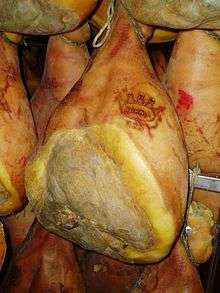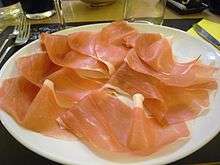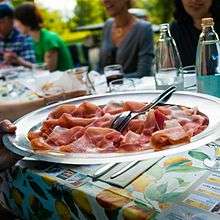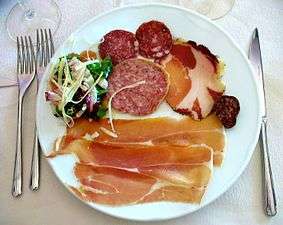Prosciutto
Prosciutto (/prəˈʃuːtoʊ, proʊˈ-/ prə-SHOO-toh, proh-,[1][2][3][4] Italian: [proʃˈʃutto])[5] is an Italian dry-cured ham that is usually thinly sliced and served uncooked; this style is called prosciutto crudo in Italian (or simply crudo) and is distinguished from cooked ham, prosciutto cotto.
 Prosciutto | |
| Alternative names | Parma ham |
|---|---|
| Course | Antipasto |
| Place of origin | Italy |
| Region or state | Po Valley |
| Similar dishes | Jamón serrano |
A number of regions have their own variations of prosciutto, each with degrees of protected status, but the most prized are the Prosciutto di Parma PDO from the Emilia-Romagna region and the Prosciutto di San Daniele PDO from the Friuli Venezia Giulia region. Unlike Italian Speck, based on the South Tyrol region and also known as Speck Alto Adige PGI, which is also a dry-cured ham, prosciutto is not smoked.
The names prosciutto and prosciutto crudo are generic, and not protected designations, and may name or describe a variety of hams more or less similar to Italian prosciutto crudo or other dry-cured hams worldwide.[6][7][8]

Etymology
The word prosciutto is derived from Latin pro (before) + exsuctus (past participle of exsugere "to suck out [the moisture]"); the Portuguese presunto has the same etymology. It is similar to the modern Italian verb prosciugare "to dry thoroughly" (from Latin pro + exsucare "to extract the juices from").[9]
Manufacture
Prosciutto is made from either a pig's or a wild boar's hind leg or thigh, and the base term prosciutto specifically refers to this product. Prosciutto may also be made using the hind leg of other animals, in which case the name of the animal is included in the name of the product, for example "prosciutto cotto d'agnello" ("lamb prosciutto"). The process of making prosciutto can take from nine months to two years, depending on the size of the ham.
A writer on Italian food, Bill Buford, describes talking to an old Italian butcher who says:
When I was young, there was one kind of prosciutto. It was made in the winter, by hand, and aged for two years. It was sweet when you smelled it. A profound perfume. Unmistakable. To age a prosciutto is a subtle business. If it's too warm, the aging process never begins. The meat spoils. If it's too dry, the meat is ruined. It needs to be damp but cool. The summer is too hot. In the winter—that's when you make salumi. Your prosciutto. Your soppressata. Your sausages.[10]
Today, the ham is first cleaned, salted, and left for about two months. During this time, the ham is pressed, gradually and carefully so as to avoid breaking the bone, to drain all blood left in the meat. Next, it is washed several times to remove the salt, and is hung in a dark, well-ventilated environment. The surrounding air is important to the final quality of the ham; the best results are obtained in a cold climate. The ham is then left until dry. The time this takes varies, depending on the local climate and size of the ham. When the ham is completely dry, it is hung to air, either at room temperature or in a controlled environment, for up to 18 months.
Prosciutto is sometimes cured with nitrites (either sodium or potassium), which are generally used in other hams to produce the desired rosy color and unique flavor, but only sea salt is used in Protected Designation of Origin hams. Such rosy pigmentation is produced by a direct chemical reaction of nitric oxide with myoglobin to form nitrosomyoglobin, followed by concentration of the pigments due to drying. Bacteria convert the added nitrite or nitrate to nitric oxide.
Use
Sliced prosciutto crudo in Italian cuisine is often served as an antipasto, wrapped around grissini, or accompanied with melon or figs. It is also eaten as accompaniment to cooked spring vegetables, such as asparagus or peas. It may be included in a simple pasta sauce made with cream, or a Tuscan dish of tagliatelle and vegetables. It is used in stuffings for other meats, such as veal, as a wrap around veal or steak, in a filled bread, or as a pizza topping.
Saltimbocca is an Italian veal dish, where escalopes of veal are topped with a sage leaf before being wrapped in prosciutto and then pan-fried. Prosciutto is often served in sandwiches and panini, sometimes in a variation on the Caprese salad, with basil, tomato and fresh mozzarella.
European Union Protected Designations of Origin

Under the Common Agricultural Policy of the European Union (EU), certain well-established meat products, including some local prosciutto, are covered by a Protected Designation of Origin (PDO) – DOP in Italian – and other, less stringent designations of geographical origin for traditional specialties. Various regions have their own PDO, whose specifications do not in general require ham from free-range pigs.
The two famous types of Italian prosciutto crudo are: prosciutto crudo di Parma, from Parma, and prosciutto crudo di San Daniele, from the San Daniele del Friuli area, in the Friuli-Venezia Giulia region.[11] The prosciutto di Parma has a slightly nutty flavor from the Parmigiano Reggiano whey that is sometimes added to the pigs' diet. The prosciutto di San Daniele, though, is darker in color and sweeter in flavor. For both of them, the product specifications completely prohibit additives such as nitrite and nitrate that are often present in unprotected products.[12][13]
EU-protected designations for prosciutto in Italy, each slightly different in color, flavor, and texture, are:
- Prosciutto di Parma, Italy, PDO
- Prosciutto di San Daniele, Italy, PDO
- Prosciutto di Modena, Italy, PDO
- Prosciutto Toscano, Italy, PDO
- Prosciutto Veneto Berico-Euganeo, Italy, PDO
- Prosciutto di Carpegna, near Montefeltro, Italy, PDO
- Prosciutto di Norcia, Italy, PGI
- Prosciutto di Sauris, Italy, PGI
- Crudo di Cuneo, Italy, PDO
Culatello
.jpg)
Culatello is similar to prosciutto but is made from the filet or loin of the hind leg. It is cured primarily with salt only and aged in a beef or hogs bladder as a casing to prevent spoilage and contamination. Culatello di Zibello possesses PDO status. It is commonly served as a starter.
Strolghino is a salame prepared from leftover cuts of culatello.[14]
Pršut

The Italian name prosciutto was adapted to Slavic pršut in the eastern Adriatic. In Montenegro, Bosnia and Herzegovina, Slovenia (especially the Karst Plateau and the Vipava Valley), Serbia, and Croatia (Dalmatia, Island of Krk and Istria), pršut is a common form of dry-cured ham. Pršut from Dalmatia, Herzegovina and Serbia is smoked, unlike the Italian product, while that from Slovenia, Istria and Krk is not smoked. A mountain village in Montenegro produces a delicacy known as njeguški pršut.
The Slovenian variant Kraški pršut and the Croatian variants Dalmatinski pršut, Krčki pršut and Istarski pršut have a Protected Geographical Indication within the EU.[15][16]
See also
- Dry-cured ham
- Coppa or capicola, made in Italy from dry-cured pork shoulder
- Bresaola, made in northern Italy from air-dried beef
- Salo, salted lard made in the Eastern Europe
- Jinhua ham, a dry-cured ham made in China
- Country ham, a method of curing pork originating from the Southern U.S., also widely known as "Virginia ham"
- Bayonne ham, also known as Jambon de Bayonne, a dry-cured ham made in France
- Jamón serrano, a dry-cured ham made in Spain
- Jamón ibérico / Presunto pata negra, a dry-cured ham made in Spain and Portugal
- Presunto, dry-cured ham made in Portugal
- Elenski but or ham from Elena, a dry-cured and air-dried ham made traditionally in Bulgaria, Elena region
- List of hams – Wikipedia list article
- List of dried foods – Wikipedia list article
- List of smoked foods
Notes and references
- "PROSCIUTTO". Cambridge English Dictionary. Cambridge University Press. Retrieved 14 August 2019.
- "prosciutto". Lexico UK Dictionary. Oxford University Press. Retrieved 14 August 2019.
- "Prosciutto". Collins English Dictionary. HarperCollins. Retrieved 14 August 2019.
- "prosciutto". Merriam-Webster Dictionary. Retrieved 14 August 2019.
- Entry prosciutto in the Dizionario d'ortografia e di pronunzia, by Bruno Migliorini, Carlo Tagliavini, Piero Fiorellihan and Tommaso Francesco Bórri.
- Florence Fabricant, "A New American Prosciutto", New York Times October 2, 2017
- El Artesano, "1st Argentinian Prosciutto"
- "Ακροκώλιον, το καλύτερο ελληνικό προσούτο φτιάχνεται στην Ευρυτανία", viewtag.gr, September 14, 2016
- OED sv. prosciutto, n.; Dizionario etimologico online sv. Prosciutto, Presciutto and Prosciugare; Lewis & Short sv. ex-sūco
- Buford, Bill Heat: An Amateur's Adventures as Kitchen Slave, Line Cook, Pasta-Maker, and Apprentice to a Dante-Quoting Butcher in Tuscany Knopf, 2006 ISBN 1-4000-4120-1
- S. Irene Virbila (January 29, 1989). "Fare of the Country; The Sweet Prosciutto Of San Danieli, Italy". The New York Times. Retrieved November 9, 2009.
- "Technical Specifications of Parma Ham" (PDF). prosciuttodiparma.com. July 11, 2006. Retrieved November 20, 2013.
Additives: None. Only the use of salt is allowed (sodium chloride).
- "Production guidelines". Consorzio del Prosciutto di San Daniele. Retrieved November 20, 2013.
Sea salt is used exclusively for salting, as the use of other chemical substances, preservatives and additives is completely prohibited throughout the preparation.
- Petrini, Carlo; Padovani, Gigi (2006-10-17). Slow food revolution. p. 78.
- "DOOR". ec.europa.eu.
- "Dalmatian Pršut Given EU Protection Status".
Further reading
- McGee, Harold. On Food and Cooking (revised). New York, New York: Scribner, 2004. ISBN 0-684-80001-2
External links
| Wikimedia Commons has media related to Ham from Italy. |